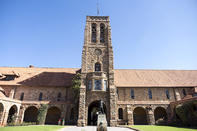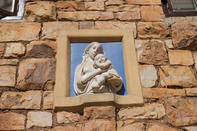Sir Herbert Baker
The St John's school buildings, as they stand today are a tribute to the great architect Sir Herbert Baker, who designed the earlier buildings which set the theme, and who drew up the master plan faithfully followed by his partner and successor, Frank Fleming, and to the man who started it all, Reverend James Nash, headmaster from 1907 to 1917.

The ideals of the three 'master builders' of St John's were well explained by Eustace Hill who in the difficult economic winter of 1922 said, “We mean, in spite of the depression, to start building, and the building should be in stone, not brick.
We want our buildings to embody our ideals, which are not primarily utilitarian. The ideal of all education is to know God, and beautiful buildings help to give the right atmosphere and to remind us of our ideal.”
Organic Architecture

All the buildings in the school complex created before 1946 were designed by either Baker or Fleming, and most of those up to the present are in accordance with Baker's master plan of 1907. Like a jigsaw puzzle, the buildings were created piece by piece to fit in with Baker's great conception.
Today the entire complex stretches for 300 m, along St David Road, from east to west, all in comfortable harmony. The masonry walls were built from the attractive Orange Grove quartzite which was quarried on the site; it can be said that the walls literally grew out of their site - truly organic architecture.
The original school buildings (which now serve as the preparatory school) were designed around three sides of a quadrangle, looking northwards over a grand expanse of the Highveld. While the ground floor and arches were built of stone, funds decreed that whitewashed brick was used above, in what can best be described as typical Baker Highveld style. This alliance between site, building and materials is, according to Baker's biographer Doreen Greig, 'the highest architectural quality of any school in South Africa'.
Old Johannians
The entire St John's complex is today a very large establishment, consisting of the college, the preparatory school, and the pre-preparatory school, each with its own head, with a total enrolment of nearly 1 100 pupils. During Reverend Clarke's time the college was very much a boarding establishment, with boarders coming from far and wide.
Today it is very much a day school (only 90 out of 620 senior boys are boarders), with parents taking a far more prominent role. It was also one of the first schools in the country to become non-racial.
The St John's College Old Boys' Association, the Old Johannians, founded in 1903 with the objective of keeping Old Boys in touch with the school and to form cricket and football clubs, today has nearly 2 500 members.
Old Johannians are often surprised to see how their school has grown and altered over the years, yet note that its basic ethos remains unaltered: in the words of the school prayer, 'to send out many rightly trained in body, mind and character to serve Thee well in church and state.'